Abstract
The plant alkaloid ryanodine, known to interact selectively with the intracellular Ca(2+)-release channel in skeletal and cardiac muscles, has been repeatedly reported to affect smooth-muscle contractile functions that are consistent with its intracellular action at the Ca(2+)-release channel sites. Direct evidence for the binding of [3H]ryanodine to smooth-muscle membranes is sparse. Following our recent detailed characterization of functional effects of ryanodine and a preliminary report on the presence of [3H]ryanodine binding sites in rat vas deferens smooth muscle, we now report in this study a detailed characterization of binding of [3H]ryanodine to smooth muscle at the subcellular-membrane level. The ryanodine receptor in rat vas deferens muscle layer is primarily of smooth-muscle origin and is localized at the subcellular membrane site that is consistent with its role as a Ca(2+)-release channel in the sarcoplasmic reticulum (SR). Ryanodine binding to its receptor is Ca(2+)-dependent, with half-maximal binding occurring within the physiologically relevant cytosolic Ca2+ concentration. It is also sensitive to many factors, including change in Mg2+ concentration, ionic strength and osmolarity across the membrane vesicles. Agents known to inhibit (Ruthenium Red, Mg2+) or enhance (caffeine, Na+, K+) the Ca(2+)-induced Ca2+ release also inhibit or enhance the binding of ryanodine. Quantitative differences in ryanodine receptors exist among smooth muscles and do not seem to parallel their SR contents. Results from the present study indicate both the need and the basis for future investigations of the functional role of the ryanodine receptor in different smooth muscles.
Full text
PDF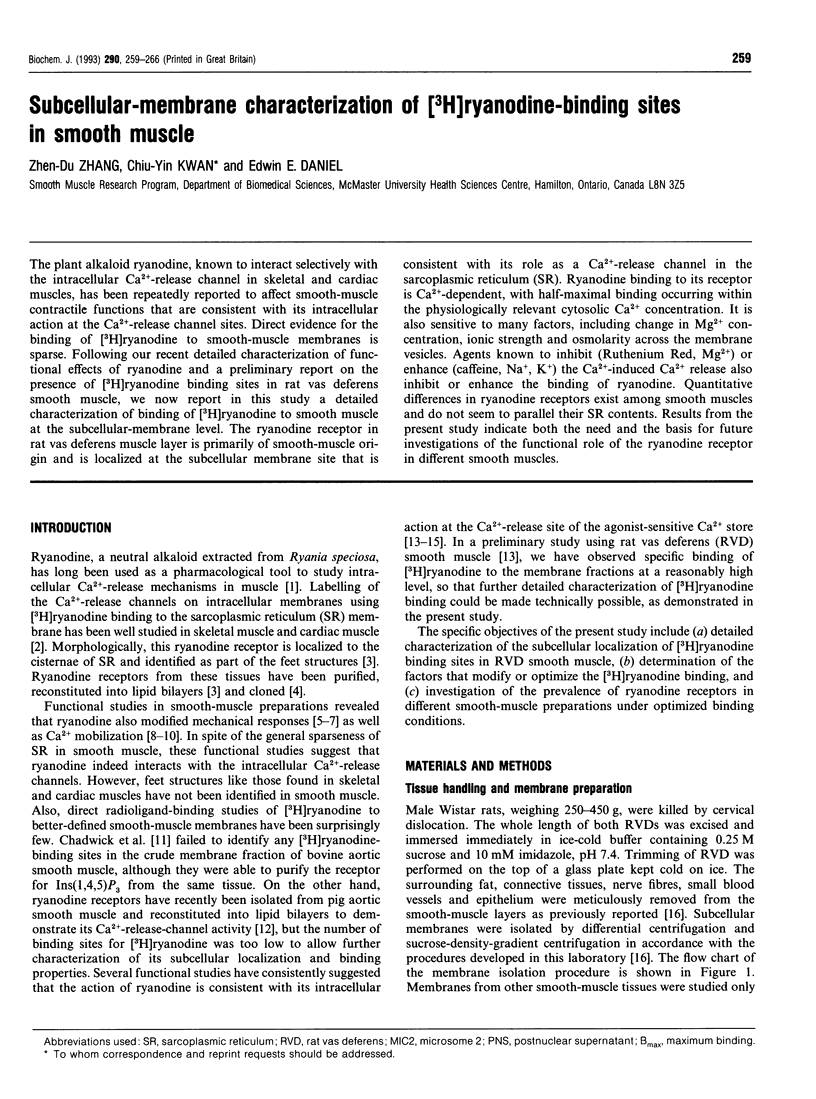
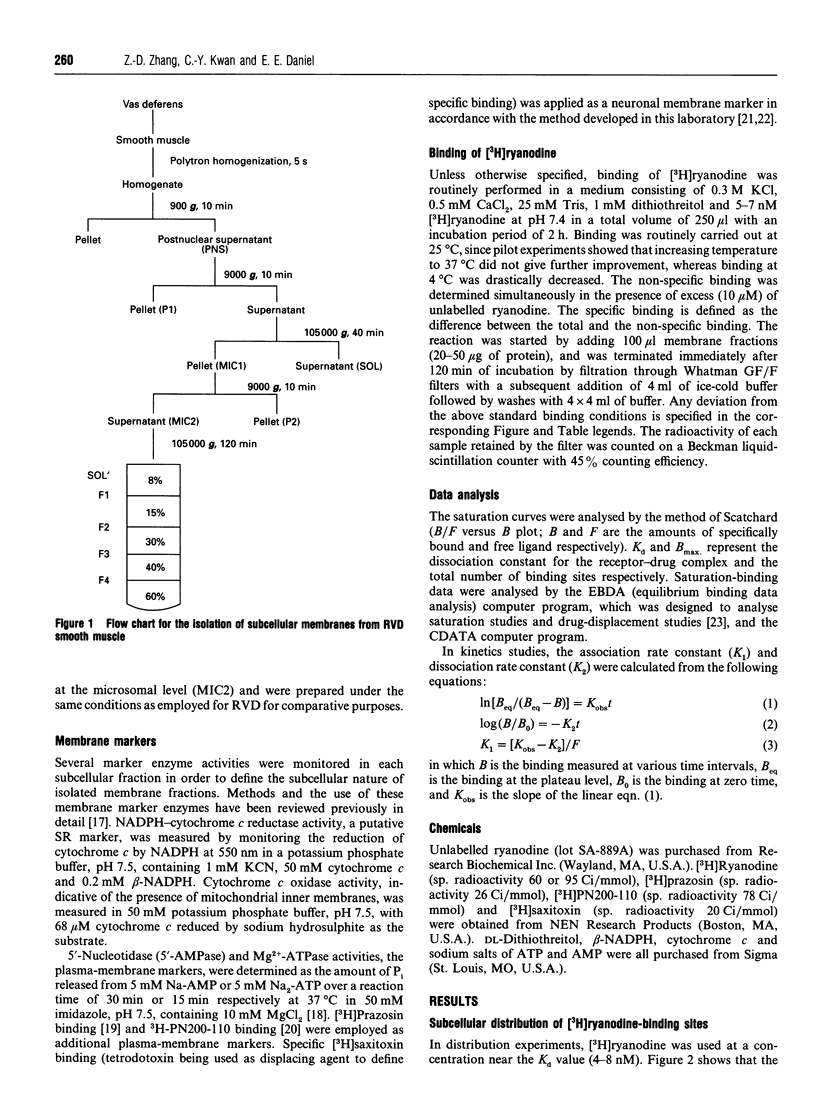
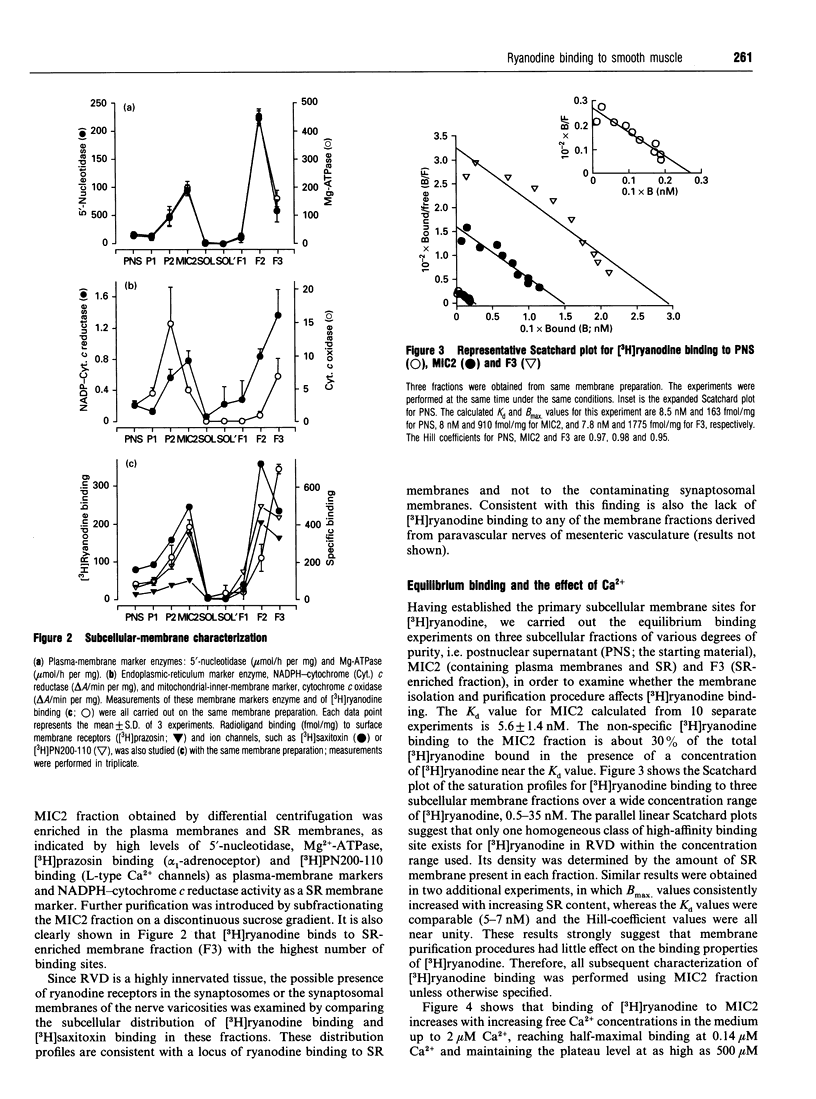
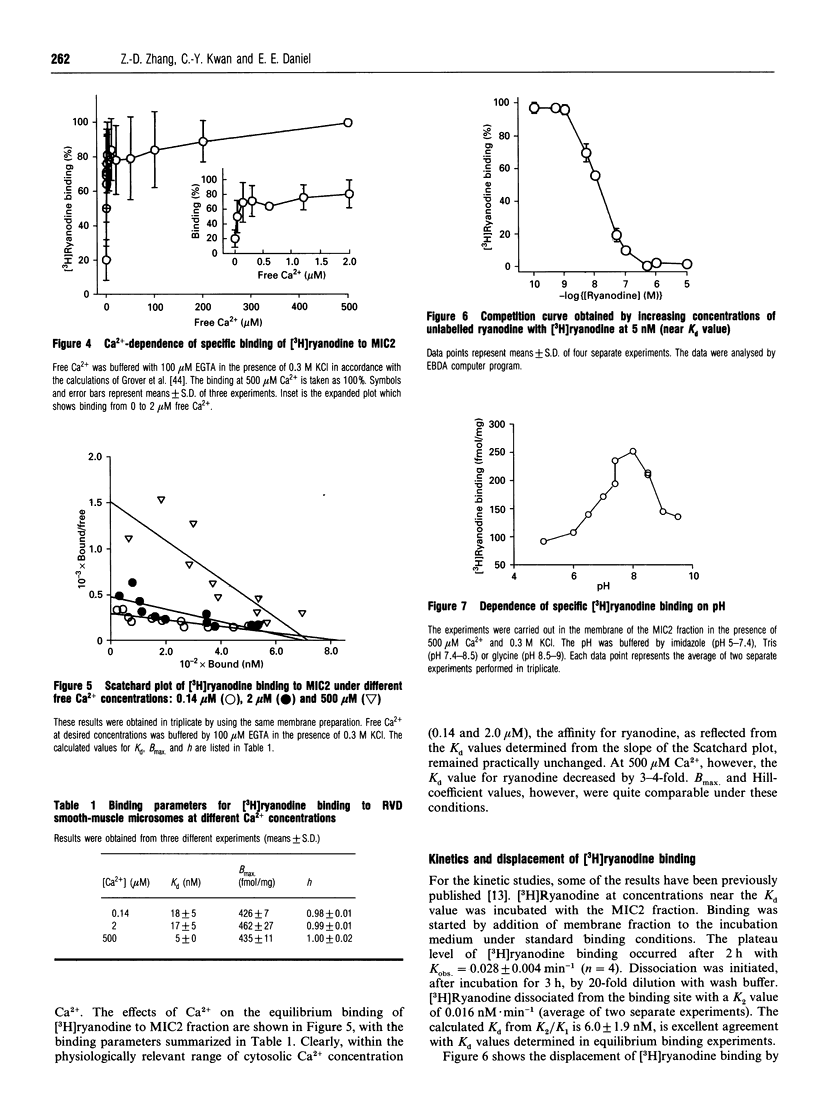
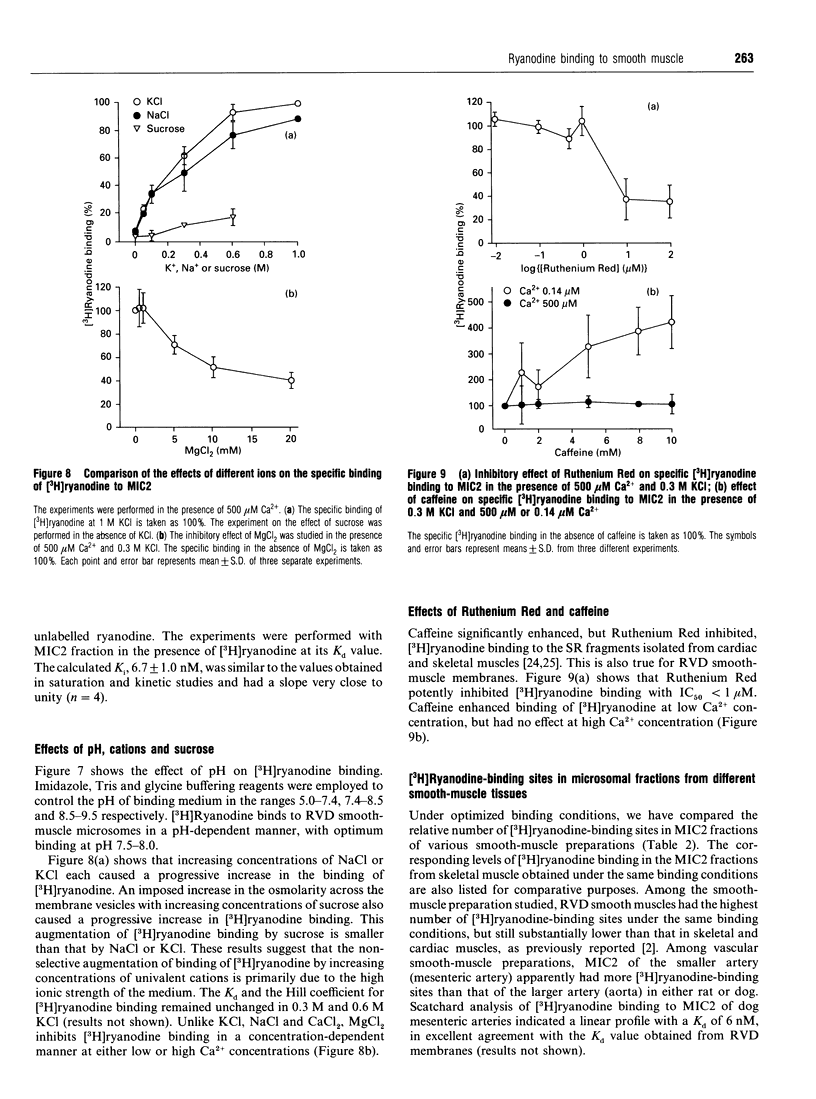
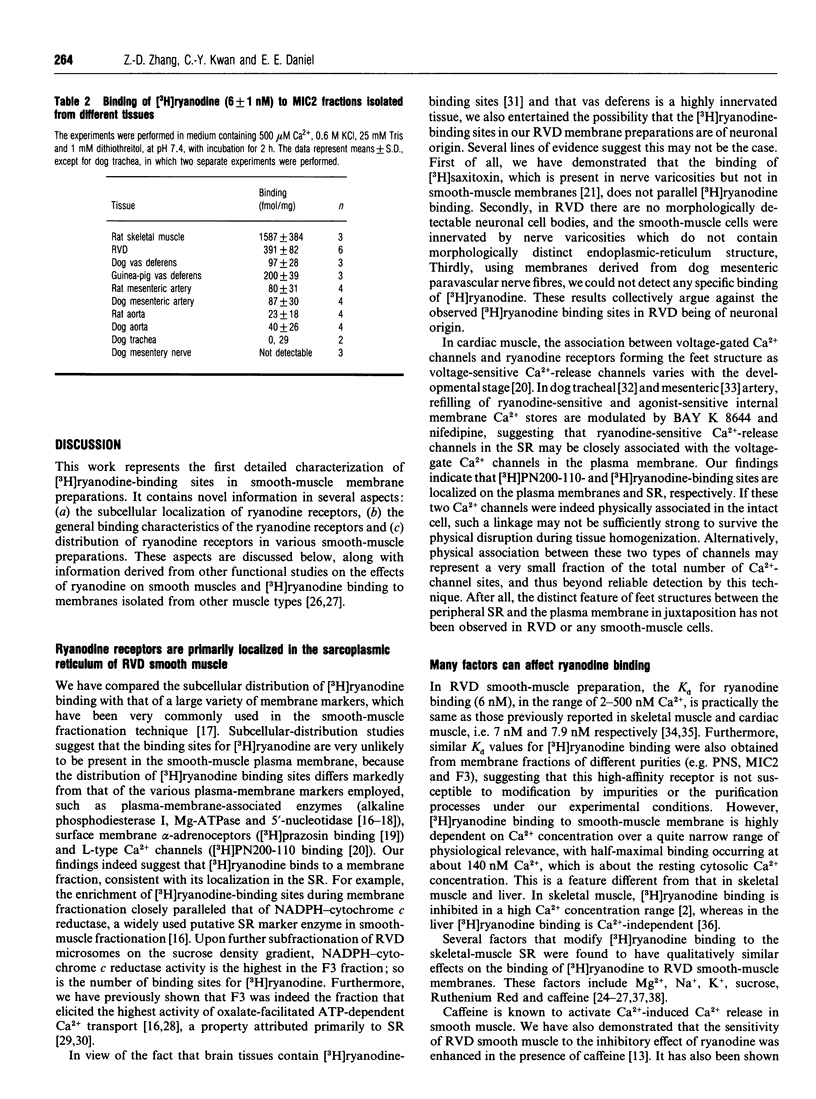
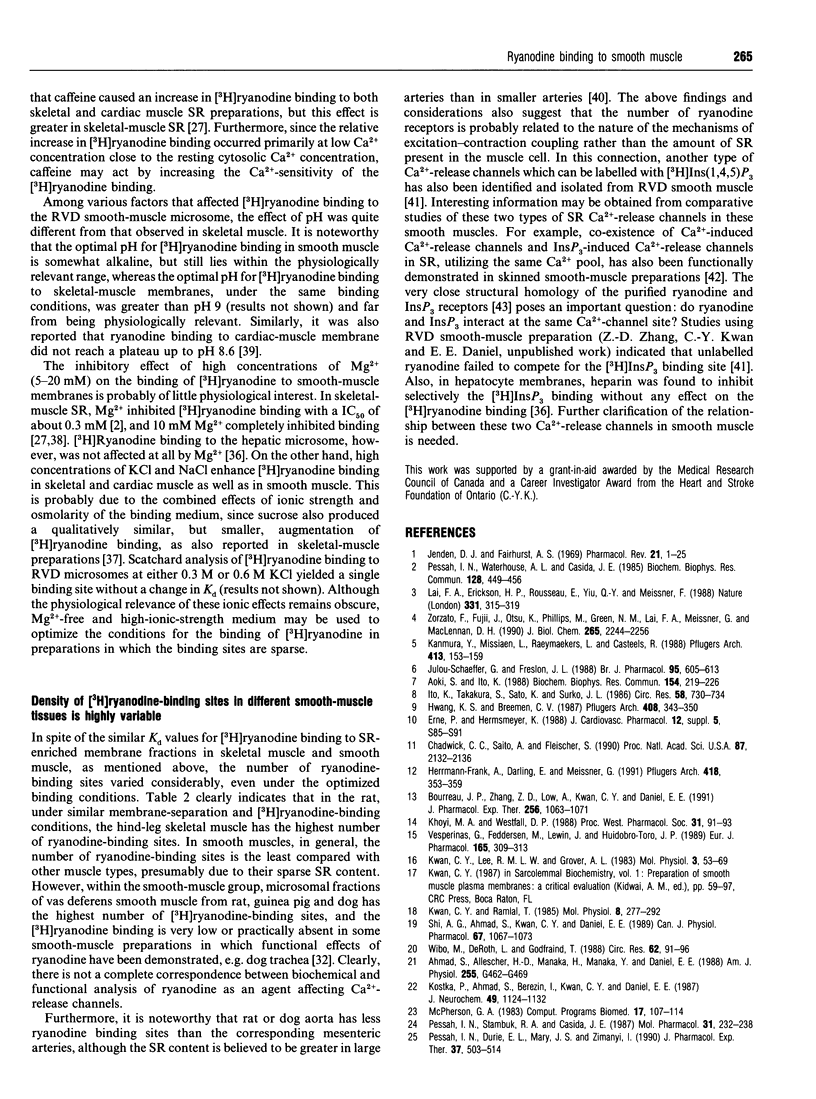
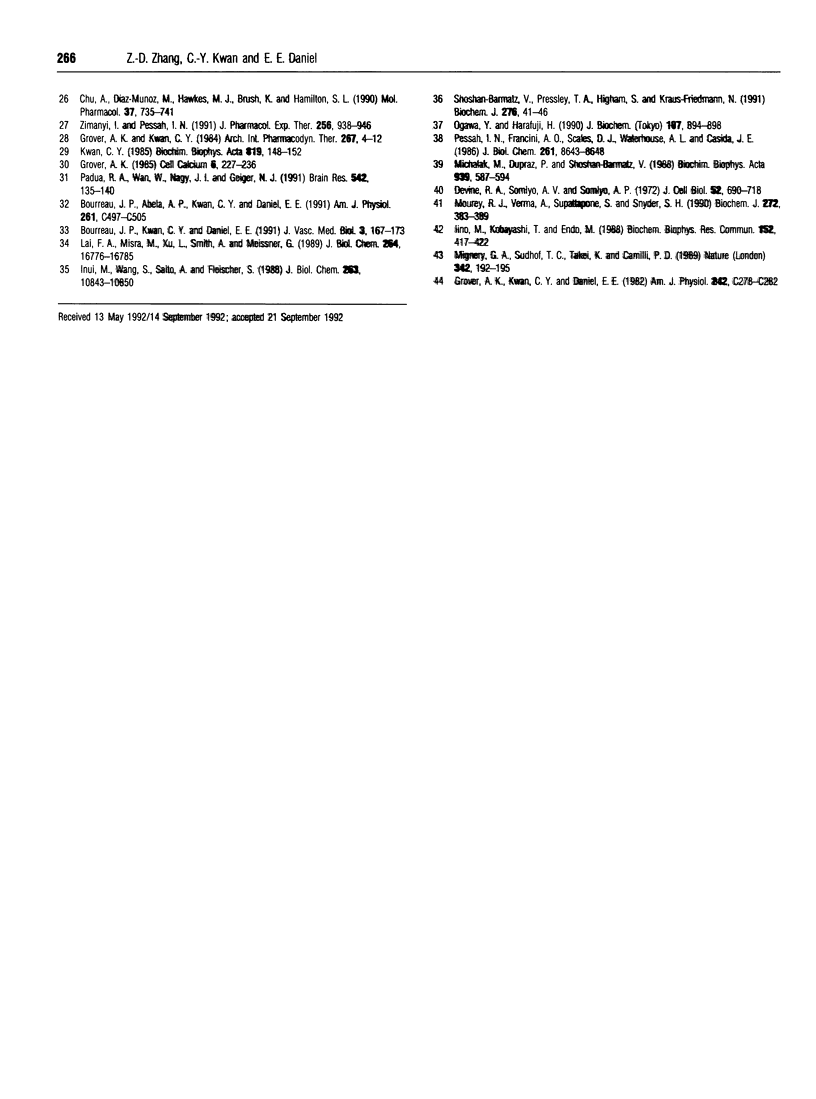
Selected References
These references are in PubMed. This may not be the complete list of references from this article.
- Ahmad S., Allescher H. D., Manaka H., Manaka Y., Daniel E. E. [3H]saxitoxin as a marker for canine deep muscular plexus neurons. Am J Physiol. 1988 Oct;255(4 Pt 1):G462–G469. doi: 10.1152/ajpgi.1988.255.4.G462. [DOI] [PubMed] [Google Scholar]
- Aoki S., Ito K. Time- and use-dependent inhibition by ryanodine of caffeine-induced contraction of guinea-pig aortic smooth muscle. Biochem Biophys Res Commun. 1988 Jul 15;154(1):219–226. doi: 10.1016/0006-291x(88)90673-0. [DOI] [PubMed] [Google Scholar]
- Bourreau J. P., Abela A. P., Kwan C. Y., Daniel E. E. Acetylcholine Ca2+ stores refilling directly involves a dihydropyridine-sensitive channel in dog trachea. Am J Physiol. 1991 Sep;261(3 Pt 1):C497–C505. doi: 10.1152/ajpcell.1991.261.3.C497. [DOI] [PubMed] [Google Scholar]
- Bourreau J. P., Zhang Z. D., Low A. M., Kwan C. Y., Daniel E. E. Ryanodine and the adrenergic, purinergic stimulation in the rat vas deferens smooth muscle: functional and radioligand binding studies. J Pharmacol Exp Ther. 1991 Mar;256(3):1063–1071. [PubMed] [Google Scholar]
- Chadwick C. C., Saito A., Fleischer S. Isolation and characterization of the inositol trisphosphate receptor from smooth muscle. Proc Natl Acad Sci U S A. 1990 Mar;87(6):2132–2136. doi: 10.1073/pnas.87.6.2132. [DOI] [PMC free article] [PubMed] [Google Scholar]
- Chu A., Díaz-Muñoz M., Hawkes M. J., Brush K., Hamilton S. L. Ryanodine as a probe for the functional state of the skeletal muscle sarcoplasmic reticulum calcium release channel. Mol Pharmacol. 1990 May;37(5):735–741. [PubMed] [Google Scholar]
- Erne P., Hermsmeyer K. Intracellular Ca2+ release in vascular muscle cells by caffeine, ryanodine, norepinephrine, and neuropeptide Y. J Cardiovasc Pharmacol. 1988;12 (Suppl 5):S85–S91. [PubMed] [Google Scholar]
- Grover A. K., Kwan C. Y. ATP-dependent Ca-uptake by rat vas deferens smooth muscle microsomes: properties of oxalate stimulated and oxalate-independent Ca-uptake. Arch Int Pharmacodyn Ther. 1984 Jan;267(1):4–12. [PubMed] [Google Scholar]
- Herrmann-Frank A., Darling E., Meissner G. Functional characterization of the Ca(2+)-gated Ca2+ release channel of vascular smooth muscle sarcoplasmic reticulum. Pflugers Arch. 1991 May;418(4):353–359. doi: 10.1007/BF00550873. [DOI] [PubMed] [Google Scholar]
- Hwang K. S., van Breemen C. Ryanodine modulation of 45Ca efflux and tension in rabbit aortic smooth muscle. Pflugers Arch. 1987 Apr;408(4):343–350. doi: 10.1007/BF00581127. [DOI] [PubMed] [Google Scholar]
- Ito K., Takakura S., Sato K., Sutko J. L. Ryanodine inhibits the release of calcium from intracellular stores in guinea pig aortic smooth muscle. Circ Res. 1986 May;58(5):730–734. doi: 10.1161/01.res.58.5.730. [DOI] [PubMed] [Google Scholar]
- Jenden D. J., Fairhurst A. S. The pharmacology of ryanodine. Pharmacol Rev. 1969 Mar;21(1):1–25. [PubMed] [Google Scholar]
- Julou-Schaeffer G., Freslon J. L. Effects of ryanodine on tension development in rat aorta and mesenteric resistance vessels. Br J Pharmacol. 1988 Oct;95(2):605–613. doi: 10.1111/j.1476-5381.1988.tb11682.x. [DOI] [PMC free article] [PubMed] [Google Scholar]
- Kanmura Y., Missiaen L., Raeymaekers L., Casteels R. Ryanodine reduces the amount of calcium in intracellular stores of smooth-muscle cells of the rabbit ear artery. Pflugers Arch. 1988 Dec;413(2):153–159. doi: 10.1007/BF00582525. [DOI] [PubMed] [Google Scholar]
- Khoyi M. A., Westfall D. P. Effects of ryanodine on the smooth muscle of the rat vas deferens. Proc West Pharmacol Soc. 1988;31:91–93. [PubMed] [Google Scholar]
- Kostka P., Ahmad S., Berezin I., Kwan C. Y., Allescher H. D., Daniel E. E. Subcellular fractionation of the longitudinal smooth muscle/myenteric plexus of dog ileum: dissociation of the distribution of two plasma membrane marker enzymes. J Neurochem. 1987 Oct;49(4):1124–1132. doi: 10.1111/j.1471-4159.1987.tb10002.x. [DOI] [PubMed] [Google Scholar]
- Kwan C. Y. Subcellular origin of the oxalate- or inorganic phosphate-stimulated Ca2+ transport by smooth muscle microsomes: revisitation of the old problem by a new approach using saponin. Biochim Biophys Acta. 1985 Sep 25;819(1):148–152. doi: 10.1016/0005-2736(85)90206-8. [DOI] [PubMed] [Google Scholar]
- Lai F. A., Erickson H. P., Rousseau E., Liu Q. Y., Meissner G. Purification and reconstitution of the calcium release channel from skeletal muscle. Nature. 1988 Jan 28;331(6154):315–319. doi: 10.1038/331315a0. [DOI] [PubMed] [Google Scholar]
- Lai F. A., Misra M., Xu L., Smith H. A., Meissner G. The ryanodine receptor-Ca2+ release channel complex of skeletal muscle sarcoplasmic reticulum. Evidence for a cooperatively coupled, negatively charged homotetramer. J Biol Chem. 1989 Oct 5;264(28):16776–16785. [PubMed] [Google Scholar]
- McPherson G. A. A practical computer-based approach to the analysis of radioligand binding experiments. Comput Programs Biomed. 1983 Aug-Oct;17(1-2):107–113. doi: 10.1016/0010-468x(83)90031-4. [DOI] [PubMed] [Google Scholar]
- Padua R. A., Wan W. H., Nagy J. I., Geiger J. D. [3H]ryanodine binding sites in rat brain demonstrated by membrane binding and autoradiography. Brain Res. 1991 Feb 22;542(1):135–140. doi: 10.1016/0006-8993(91)91007-n. [DOI] [PubMed] [Google Scholar]
- Pessah I. N., Durie E. L., Schiedt M. J., Zimanyi I. Anthraquinone-sensitized Ca2+ release channel from rat cardiac sarcoplasmic reticulum: possible receptor-mediated mechanism of doxorubicin cardiomyopathy. Mol Pharmacol. 1990 Apr;37(4):503–514. [PubMed] [Google Scholar]
- Pessah I. N., Stambuk R. A., Casida J. E. Ca2+-activated ryanodine binding: mechanisms of sensitivity and intensity modulation by Mg2+, caffeine, and adenine nucleotides. Mol Pharmacol. 1987 Mar;31(3):232–238. [PubMed] [Google Scholar]
- Pessah I. N., Waterhouse A. L., Casida J. E. The calcium-ryanodine receptor complex of skeletal and cardiac muscle. Biochem Biophys Res Commun. 1985 Apr 16;128(1):449–456. doi: 10.1016/0006-291x(85)91699-7. [DOI] [PubMed] [Google Scholar]
- Shi A. G., Ahmad S., Kwan C. Y., Daniel E. E. Characterization of alpha-adrenoceptor subtypes by [3H]prazosin and [3H]rauwolscine binding to canine venous smooth muscle membranes. Can J Physiol Pharmacol. 1989 Sep;67(9):1067–1073. doi: 10.1139/y89-169. [DOI] [PubMed] [Google Scholar]
- Shoshan-Barmatz V., Pressley T. A., Higham S., Kraus-Friedmann N. Characterization of high-affinity ryanodine-binding sites of rat liver endoplasmic reticulum. Differences between liver and skeletal muscle. Biochem J. 1991 May 15;276(Pt 1):41–46. doi: 10.1042/bj2760041. [DOI] [PMC free article] [PubMed] [Google Scholar]
- Vesperinas G., Feddersen M., Lewin J., Huidobro-Toro J. P. The use of ryanodine and calcium channel blockers to characterize intra- and extracellular calcium pools mobilized by noradrenaline in the rat vas deferens. Eur J Pharmacol. 1989 Jun 20;165(2-3):309–313. doi: 10.1016/0014-2999(89)90727-9. [DOI] [PubMed] [Google Scholar]
- Wibo M., DeRoth L., Godfraind T. Pharmacologic relevance of dihydropyridine binding sites in membranes from rat aorta: kinetic and equilibrium studies. Circ Res. 1988 Jan;62(1):91–96. doi: 10.1161/01.res.62.1.91. [DOI] [PubMed] [Google Scholar]
- Zimányi I., Pessah I. N. Comparison of [3H]ryanodine receptors and Ca++ release from rat cardiac and rabbit skeletal muscle sarcoplasmic reticulum. J Pharmacol Exp Ther. 1991 Mar;256(3):938–946. [PubMed] [Google Scholar]
- Zorzato F., Fujii J., Otsu K., Phillips M., Green N. M., Lai F. A., Meissner G., MacLennan D. H. Molecular cloning of cDNA encoding human and rabbit forms of the Ca2+ release channel (ryanodine receptor) of skeletal muscle sarcoplasmic reticulum. J Biol Chem. 1990 Feb 5;265(4):2244–2256. [PubMed] [Google Scholar]


